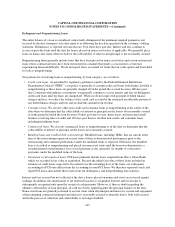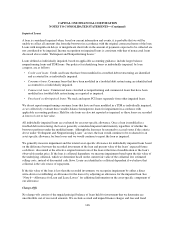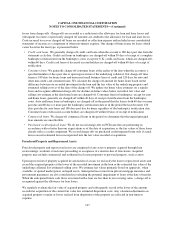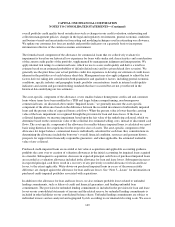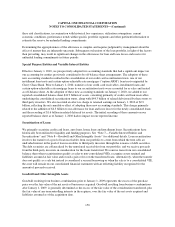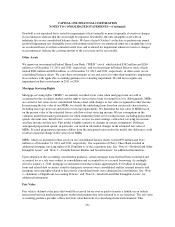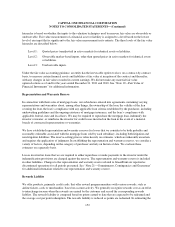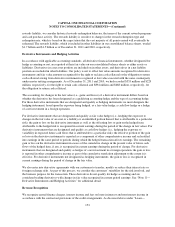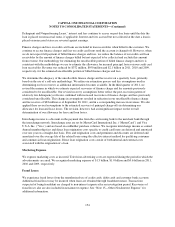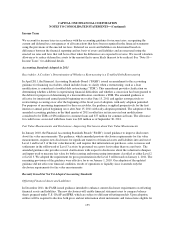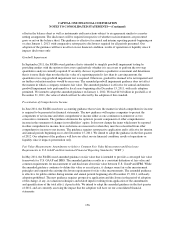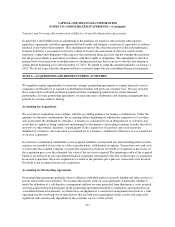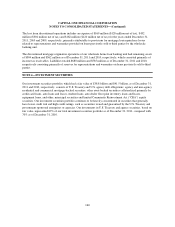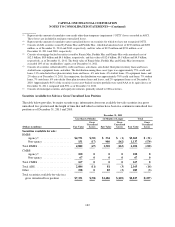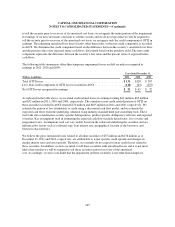Capital One 2011 Annual Report Download - page 175
Download and view the complete annual report
Please find page 175 of the 2011 Capital One annual report below. You can navigate through the pages in the report by either clicking on the pages listed below, or by using the keyword search tool below to find specific information within the annual report.CAPITAL ONE FINANCIAL CORPORATION
NOTES TO CONSOLIDATED STATEMENTS—(Continued)
Income Taxes
We account for income taxes in accordance with the accounting guidance for income taxes, recognizing the
current and deferred tax consequences of all transactions that have been recognized in the financial statements
using the provisions of the enacted tax laws. Deferred tax assets and liabilities are determined based on
differences between the financial reporting and tax basis of assets and liabilities and are measured using the
enacted tax rates and laws that will be in effect when the differences are expected to reverse. We record valuation
allowances to reduce deferred tax assets to the amount that is more likely than not to be realized. See “Note 18—
Income Taxes” for additional details.
Accounting Standards Adopted in 2011
Receivables: A Creditor’s Determination of Whether a Restructuring is a Troubled Debt Restructuring
In April 2011, the Financial Accounting Standards Board (“FASB”) issued an amendment to the accounting
guidance for financing receivables, which includes loans, to clarify when a restructuring, such as a loan
modification, is considered a troubled debt restructuring (“TDR”). This amendment provides clarification on
determining whether a debtor is experiencing financial difficulties and whether a concession has been granted to
the debtor for purposes of determining if a loan modification constitutes a TDR. The amended guidance is
effective for interim and annual periods beginning on or after June 15, 2011 and applies retrospectively to
restructurings occurring on or after the beginning of the fiscal year of adoption, with early adoption permitted.
For purposes of measuring impairment for these receivables, the guidance is applied prospectively for the first
interim or annual period beginning on or after June 15, 2011 with early adoption permitted. The adoption of this
amended accounting guidance in the third quarter of 2011 resulted in a net increase in loan modifications
considered to be TDRs of $56 million for consumer loans and $77 million for commercial loans. The allowance
for credit losses associated with these loans was $22 million as of September 30, 2011.
Fair Value Measurements and Disclosures—Improving Disclosures about Fair Value Measurements
In January 2010, the Financial Accounting Standards Board (“FASB”) issued guidance to improve disclosures
about fair value measurements. The guidance, which amended previous disclosure requirements for fair value
measurements, requires new disclosures for significant transfers of financial assets and liabilities into and out of
Level 1 and Level 2 of the fair value hierarchy, and requires that information on purchases, sales, issuances and
settlements in the rollforward of Level 3 activity be presented on a gross basis rather than on a net basis. The
amended guidance also provides several clarifications with respect to disclosures about the valuation techniques
and inputs used to measure fair value for both recurring and nonrecurring instruments classified as either Level 2
or Level 3. We adopted the requirement for gross presentation in the Level 3 rollforward on January 1, 2011. The
remaining provisions of the guidance were effective for us on January 1, 2010. Our adoption of the updated
guidance did not affect our financial condition, results of operations or liquidity since it amends only the
disclosure requirements for fair value measurements.
Recently Issued but Not Yet Adopted Accounting Standards
Offsetting Financial Assets and Liabilities
In December 2011, the FASB issued guidance intended to enhance current disclosure requirements on offsetting
financial assets and liabilities. The new disclosures will enable financial statement users to compare balance
sheets prepared under U.S. GAAP and IFRS, which are subject to different offsetting models. Upon adoption,
entities will be required to disclose both gross and net information about instruments and transactions eligible for
155


